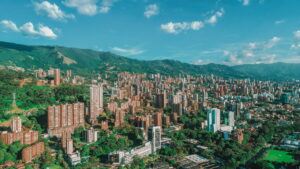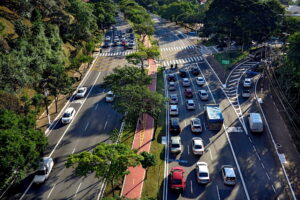Today, around 4.5 billion people worldwide live in cities, and by 2050, seventy percent of the world’s population is expected to be urban dwellers. But as is currently the case in Zurich (32°C), Athens (37°C), Madrid (38°C) or Antalya (39°C) – it can get hot in the city in summer. On average, the temperature in cities is at least 2°C higher than in surrounding areas, in extreme situations even up to 20°C. The reason for this is that the concrete, glass and stone of buildings and streets heat up considerably due to the Sun’s rays, plus large buildings often also prevent the necessary inflow of cold air.
 For a few years now, people have begun to realise that more greenery in the city can reduce the often unbearable heat. The Colombian city of Medellín is a pioneer in heat reduction through urban greening. Back in 2016, the city council of Medellín decided to counteract the heat effect by building 30 green corridors along 18 selected streets and twelve streams. In addition, green facades were added to public buildings and more than 100 new parks were built. By 2021, almost 880,000 trees and 2.5 million smaller plants had been planted in Medellin.
For a few years now, people have begun to realise that more greenery in the city can reduce the often unbearable heat. The Colombian city of Medellín is a pioneer in heat reduction through urban greening. Back in 2016, the city council of Medellín decided to counteract the heat effect by building 30 green corridors along 18 selected streets and twelve streams. In addition, green facades were added to public buildings and more than 100 new parks were built. By 2021, almost 880,000 trees and 2.5 million smaller plants had been planted in Medellin.
The result is clearly noticeable. These 30 green corridors now form a 20-kilometre network of interconnected shady paths. In the green corridors, the temperature dropped by 4.5°C. The entire urban area has cooled down by 2°C. Furthermore, the many plants have reduced air pollution because they filter particulate matter out of the air. Even more trees are therefore to be planted in the coming years, which are expected to reduce the temperature by a further four to five degrees.
The cooling of the atmosphere by trees and vegetation is based on the fact that the plants evaporate water through their leaves. In order for water to change from a liquid to a gaseous state, it requires energy in the form of heat, which it extracts from the surrounding air. The result: the air cools down. Incidentally, this does not waste any water, because the more water evaporates, the more rain falls. The water is recycled, so to speak, and remains in the region.
As a study by ETH Zurich published in the journal Nature Communications in 2021 showed, trees in particular are valuable natural air-conditioning systems. The study in 293 European cities showed that temperatures are significantly lower in urban areas with trees. In Vienna, for example, areas with trees were on average 11°C cooler in summer than built-up areas, while treeless green spaces were 5.5°C cooler.

Many other cities have already followed Medellín’s example. Bogotá and Barranquilla, also in Colombia, have now launched similar projects. São Paulo in Brazil, the largest city in South America with a population of 22.6 million, now also has a green corridor. Barcelona in Spain has been building its green infrastructure since 2020. The city of Melbourne in Australia is building five new regional parks and four new nature reserves in its urban area, more than tripling the number of green spaces. And the Asian metropolis of Singapore, which has made a name for itself as a pioneer of facade greening, is cooling the city with eight Nature Ways, which are primarily intended to increase biodiversity and currently have a total length of 43.3 kilometres. By 2030, the Nature Ways are expected to be 180 km long.
By the way: reducing rising temperatures with more trees and vegetation not only works in cities, but also on a global scale, as you can read in this article.
Quellen:
https://www.seforall.org/system/files/2021-05/Chilling-Prospects-21-SEforALL.pdf
https://goodnews-magazin.de/medellin-pflanzt-hunderttausende-baume/#:~:text=Auch%20124%20Parks%20der%20Stadt,als%202%20Grad%20Celsius%20gesenkt
https://www.20min.ch/story/klimaresistenz-gruene-korridore-gegen-die-hitze-lernt-zuerich-von-medellin-103157138
https://probaum.online/artikel/forscher-stadtbaeume-kuehlen-mehr-als-gruenflaechen-013096








